What Is A Co-Sleeper?
A co-sleeper is a bed for babies to use from birth. It attaches to your own bed or sits beside it. This keeps your baby in easy reach for nighttime care. They have their own space, yet they are close to you. Co-sleepers offer a middle ground between traditional cribs and sleeping in the same bed. Parents might choose a co-sleeper to make nursing easier. It also helps keep an eye on the newborn through the night. A co-sleeper is a safe option when it meets all safety standards. It’s a popular choice for parents wanting their baby nearby.
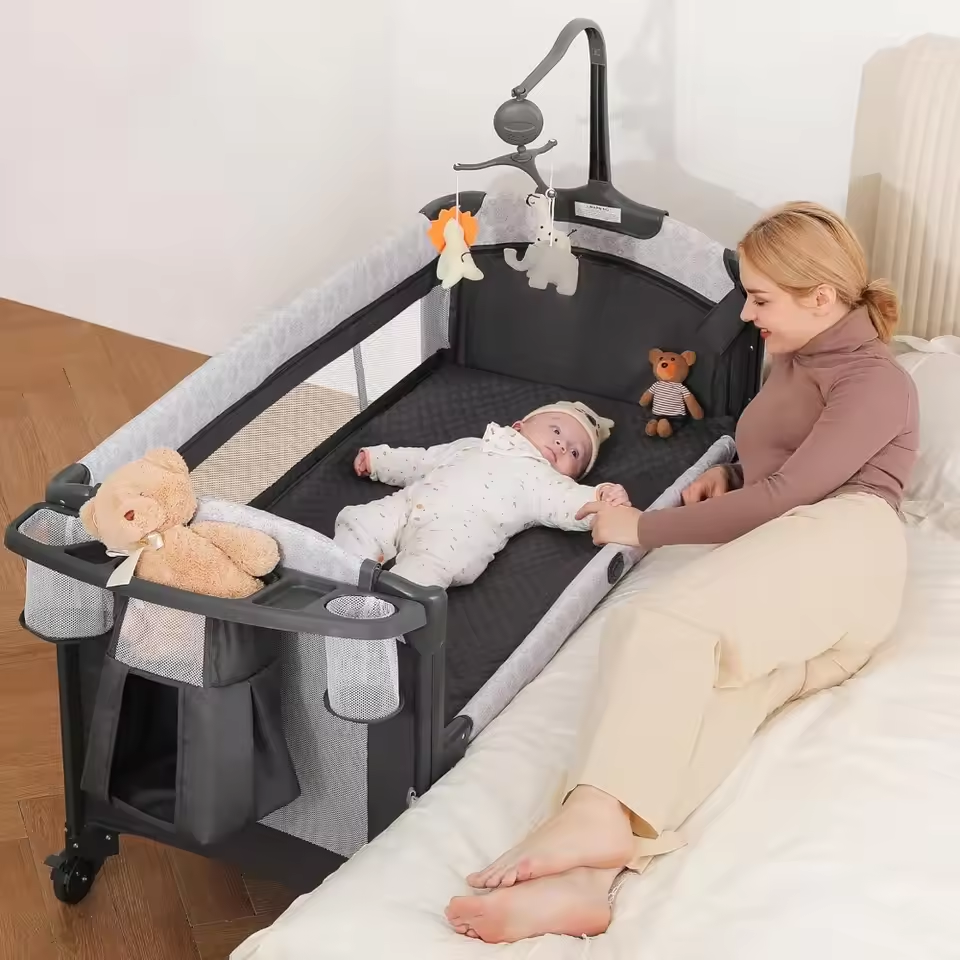
The Difference Between Co-Sleepers and Co-Sleeping
Understanding the distinction between co-sleepers and co-sleeping is key for new parents. Co-sleeping is about proximity. It’s when your baby sleeps near you. This can mean different things for different families. Some parents practice bed-sharing. This is when the baby sleeps in the adult’s bed. Others place the baby on a separate sleep surface close by.
Co-sleepers are designed for this purpose. A co-sleeper is a baby bed that fixes to the side of your bed or sits close to it. It gives your baby their own sleeping area, while still being nearby for you to easily tend to them.
The American Academy of Pediatrics (AAP) advises to keep your baby in the same room for at least six months. They recommend against bed-sharing due to safety concerns. Co-sleepers that attach to the bed or standalone near your bed help follow this guidance. They avoid the risks of bed-sharing.
Always ensure a co-sleeper is safely secured and has no gap with your bed. Safety is the top priority. Remember, never let babies sleep in the adult bed, co-sleeper or not. Bed-sharing increases safety risks significantly. Co-sleepers offer a safer alternative for keeping your baby within arm’s reach at night.
Safety Concerns with Co-Sleepers
For new parents, ensuring the safety of their newborn is a crucial concern. Co-sleepers provide many benefits, but they also come with safety considerations that must be kept in mind. Here are some safety concerns associated with co-sleepers.
Gaps and Secure Attachments
A key safety concern with a baby co-sleeper bed is the potential gap between the co-sleeper and the adult bed. Any gap can pose a serious risk for the baby. Make sure the co-sleeper attaches securely with no space left.
Sturdy Construction
The co-sleeper must have a solid build. It should not tip over or collapse. Always check for sturdy sides and a stable base.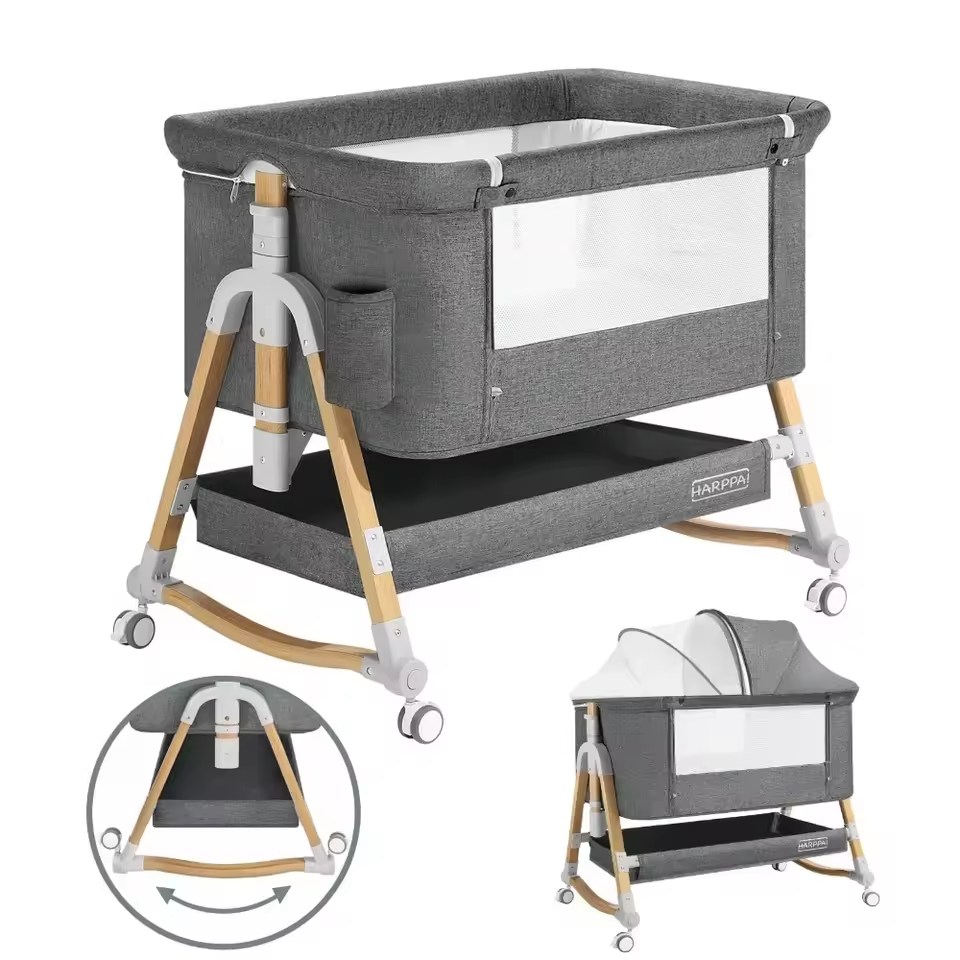
Appropriate Mattress Fit
The mattress inside the co-sleeper needs to fit perfectly. There should be no room around the edges. This prevents the baby from getting trapped.
Safe Sleeping Guidelines
The American Academy of Pediatrics recommends a clear sleep space. This means no pillows, stuffed animals, or blankets inside the co-sleeper. A fitted sheet on the mattress is all that’s needed.
Weight and Age Limits
Be aware of the weight and age limits for co-sleepers. Once your baby grows or starts rolling over or sitting up, it’s time to transition to a crib.
Proper Usage
Follow the manufacturer’s instructions for setting up and using the co-sleeper. Improper use can lead to accidents or injuries.
By being aware of these safety concerns and taking the necessary precautions, parents can create a safer sleeping environment for their baby. It’s always better to be cautious and ensure that the co-sleeper bed is up to current safety standards and in good condition.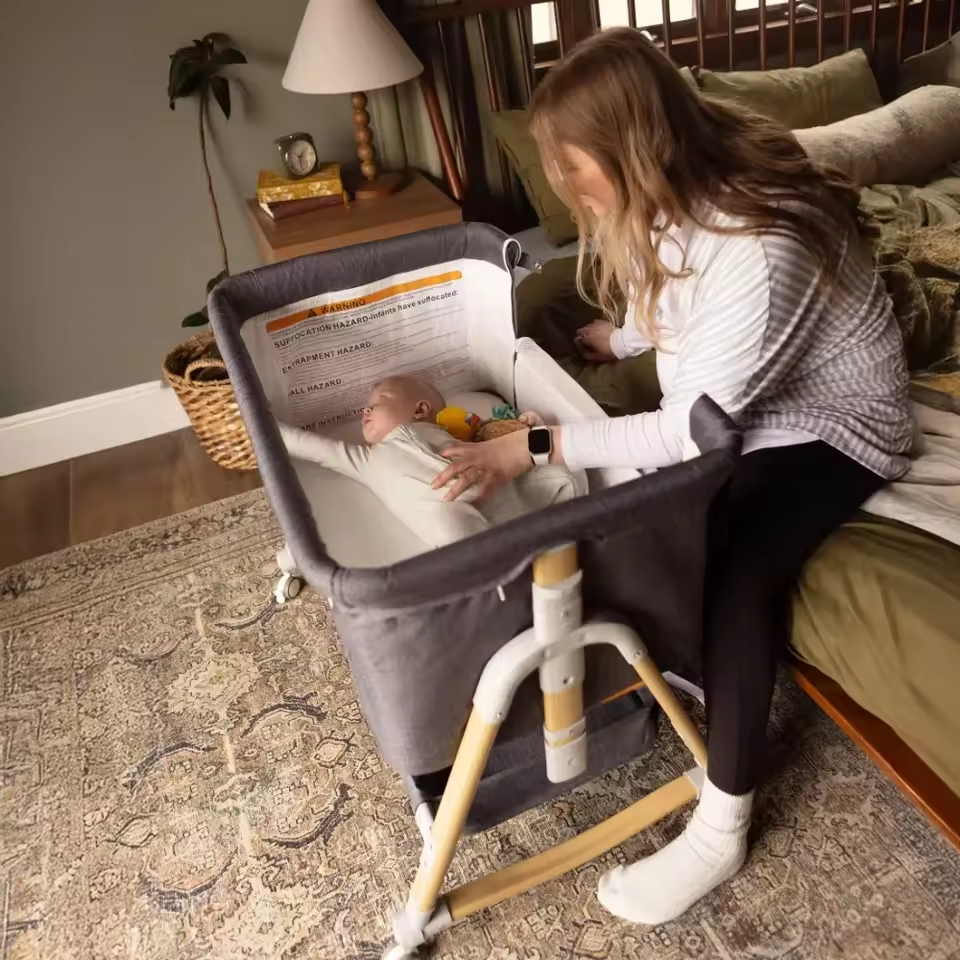
Pros and Cons of Using a Co-Sleeper
Deciding whether to use a baby co-sleeper bed comes with its advantages and challenges. Let’s dive into some of the pros and cons you might want to consider.
Advantages of Co-Sleepers
- Promotes Bonding: A co-sleeper allows you to keep your baby close, fostering a stronger bond.
- Nighttime Convenience: It’s easier to feed and comfort your baby without leaving the bed.
- Peace of Mind: Being able to see and hear your baby can ease parental anxiety.
- Safe Sleeping: A properly used co-sleeper can be part of following safe sleep guidelines.
Challenges of Co-Sleepers
- Limited Lifespan: Babies outgrow co-sleepers quickly, which can lead to additional costs.
- Space Constraints: If your bedroom is small, fitting a co-sleeper could be a challenge.
- Safety Risks: There’s a risk of potential gaps if the co-sleeper is not attached securely.
- Inconvenience: Having a co-sleeper attached to the bed can make getting in and out of bed trickier.
When weighing these factors, think about what will work best for you and your baby’s needs. Always prioritize safety and follow guidelines from trusted organizations like the American Academy of Pediatrics.
Tips for Selecting the Perfect Co-Sleeper
Selecting the ideal baby co-sleeper bed involves several factors. You must consider the space in your bedroom, the materials used, and product safety. Let’s explore these in more detail.
Consider Your Bedroom Space
The size and layout of your bedroom are crucial when looking for a co-sleeper. A co-sleeper should fit snugly and securely next to your bed. Measure the available space before making a purchase. Ensure there’s enough room for you to comfortably move around once the co-sleeper is in place. If space is tight, look for a smaller or adjustable model.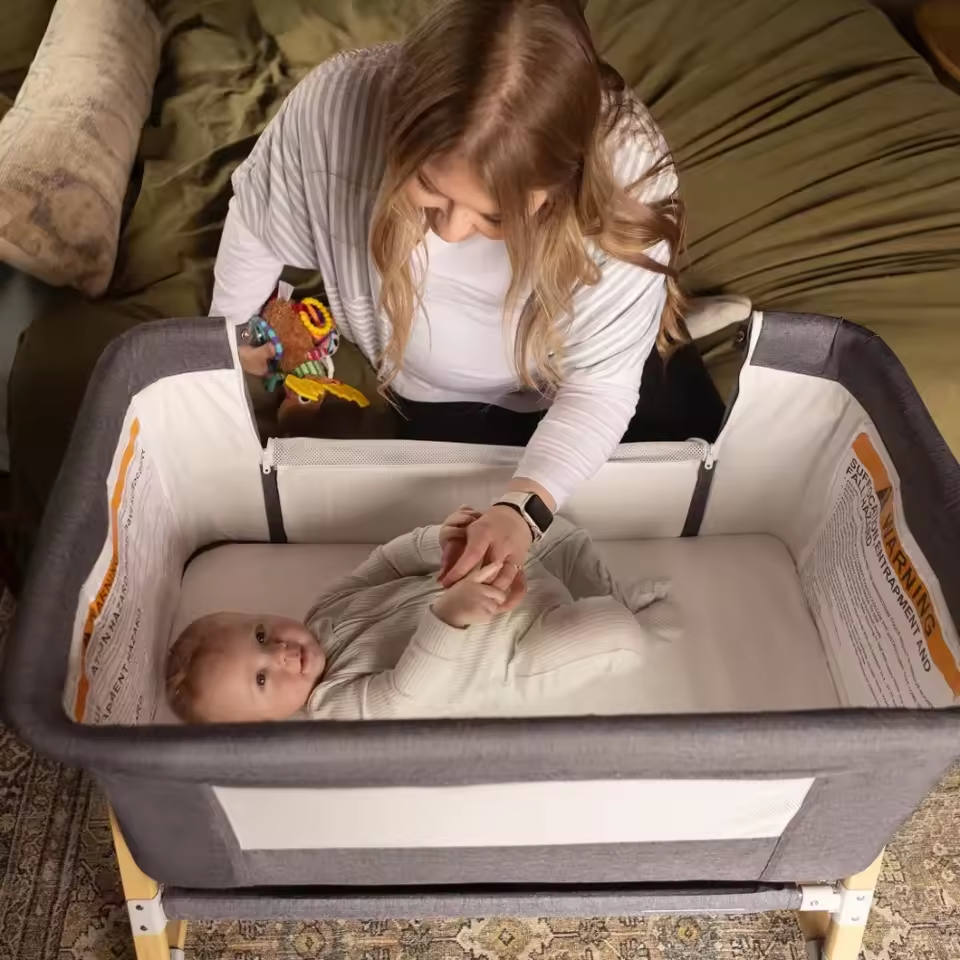
Look for Breathable Materials
Breathable materials are a key factor for a safe baby co-sleeper bed. Opt for co-sleepers with mesh sides or wooden slats. These materials enhance airflow and reduce the risk of suffocation. Breathability is essential to keep your baby cool and comfortable throughout the night.
Prioritize New and Safe Products
For the best in safety and hygiene, choose a new co-sleeper over used ones. New products are more likely to meet up-to-date safety standards. Check that the co-sleeper has no broken parts or sharp edges. It should come with a firm mattress that fits well within the bed frame. And finally, make sure it meets or exceeds current safety regulations. Safety checks are non-negotiable when it comes to your baby’s sleeping environment.
By considering these tips, you can make an informed decision. Choose a co-sleeper that is not only comfortable and convenient but also safe for your little one to sleep in.
Safety Checks When Assembling a Co-Sleeper
When you set up a baby co sleeper bed, safety comes first. Here are steps to ensure safety:
- Read Instructions Thoroughly: Understand the manual before you start. This prevents assembly errors.
- Check All Parts: Make sure you have every piece listed. Missing parts can be a hazard.
- Secure Attachments: Ensure the co-sleeper attaches firmly to your bed. It should not move or wobble.
- Test Stability: Give the co-sleeper a gentle shake. It should remain stable and upright.
- Perfect Mattress Fit: The mattress must fit snugly. Gaps are dangerous for your baby.
- Look for Sharp Edges: Feel around for any rough or sharp parts. Smooth them out or report to the manufacturer.
- Ensure Breathability: If it has sides, they should be mesh or slatted. Good airflow is crucial.
- Regularly Inspect: Check the co-sleeper often for loose bolts or wear. Keep it in safe condition.
These checks help create a safe space for your baby to sleep close to you. Always prioritize your child’s safety by following these tips and adhering to the guidelines from trustworthy sources like the American Academy of Pediatrics when using a baby co sleeper bed.
Understanding When to Transition from Co-Sleeper to Crib
Transitioning your baby from a co-sleeper to a crib is a big step for both of you. Here are a few key indicators that it’s time to make the move:
- Baby’s Growth: When your baby can roll over or sit up, it’s time to switch.
- Weight Limit: Check the co-sleeper’s weight limit. Don’t exceed it.
- Movement: More movement means less safety in a co-sleeper.
- Crib Benefits: Cribs offer more room for your baby to grow.
When your baby shows signs of outgrowing the baby co sleeper bed, start planning for a crib. This usually happens around four to six months. You want a smooth transition, so don’t wait too long. Preparing for the change early helps your baby adjust better.
Remember that each baby is different, so watch for their unique cues. Keeping safety in mind, it’s better to transition sooner rather than later. This makes sure they have a safe and suitable space to continue growing.
Finally, transitioning to a crib doesn’t mean less closeness with your baby. You can still keep the crib in your room. This follows the American Academy of Pediatrics’ advice to room-share for up to a year. You’re keeping your baby near while giving them a safe place to sleep.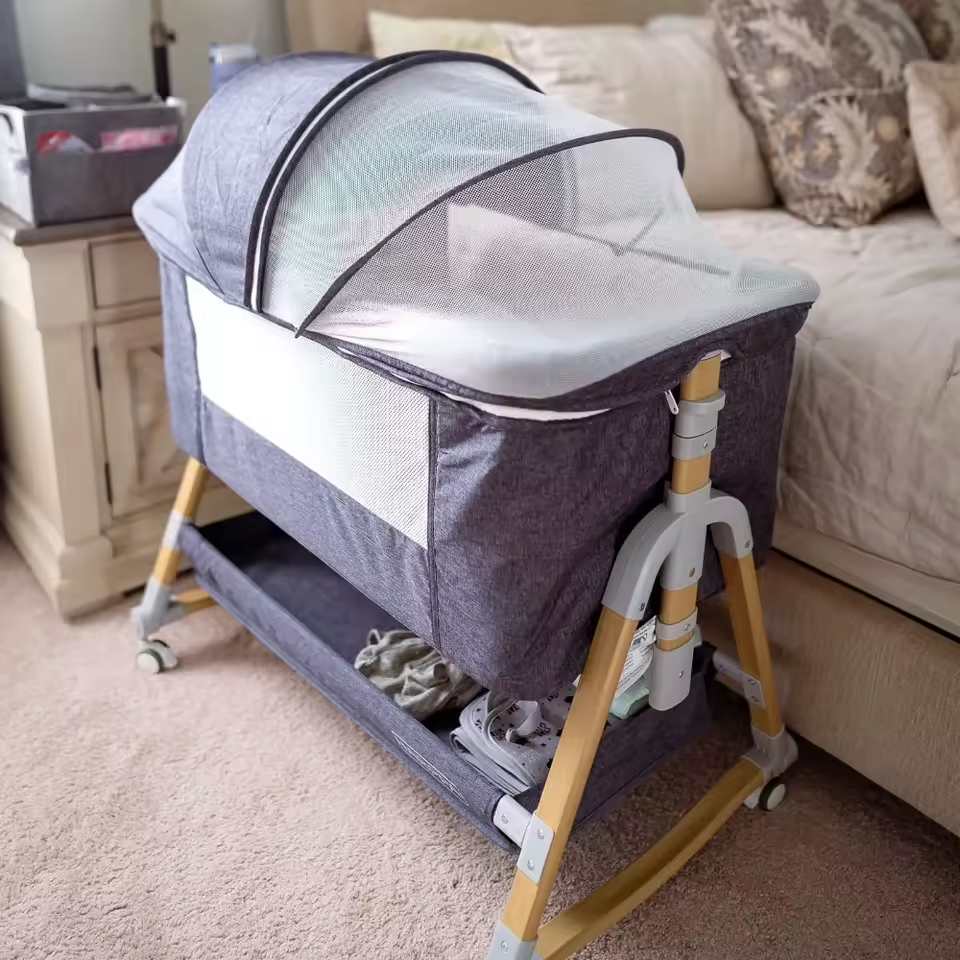
Best Practices for Creating a Safe Sleep Environment
Creating a safe sleep space for your baby is vital. Follow these best practices closely.
Always Use a Firm Mattress
Ensure your baby’s mattress is firm and fits snugly. Soft mattresses can pose suffocation risks.
Keep the Sleep Area Clear
Remove pillows, toys, and loose bedding. A fitted sheet on a firm mattress is enough.
Position Your Baby Correctly
Lay your baby on their back to sleep. This position reduces the risk of SIDS.
Avoid Overheating
Dress your baby in light clothing. Make sure the room temperature is comfortable.
Monitor Air Quality and Temperature
Keep the room well-ventilated. Use a baby monitor to check the temperature.
Use Mesh or Slatted Sides
Choose a co-sleeper with breathable sides to promote airflow and reduce suffocation risks.
Schedule Regular Safety Checks
Inspect the co-sleeper regularly for signs of damage or wear and tear.
By following these steps, you will create the safest sleep environment for your baby co sleeper bed. Always stay informed of current safety guidelines from resources like the American Academy of Pediatrics.